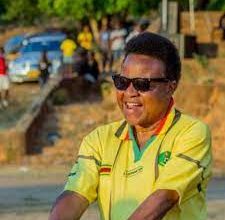
Freddy Mukwesha

By ZimLegends
A fairy tale is the best description of the adventurous journey by Freddy Mukwesha to Portugal in 1966,when he was driven to Mozambique enroute to Portugal, to become the first black Rhodesian to play football in a European league.
The surprise development came during the colonial era, when black Rhodesian football players could not dream of playing for a European club. Mukwesha was a founding member of Dynamos Football Club, an African team established in 1963 in a township in Salisbury, now Harare in Southern Rhodesia.
Dynamos, the first black team to torment established clubs, had made a grand entry into the race, winning two consecutive league championships in the predominantly white Rhodesia National Football League.
Where it not for the Unilateral Declaration of Independence by Ian Douglas Smith in 1965, Mukwesha would not have played for the Rhodesia national squad,an opportunity that exposed him to a touring European club.
It was only after UDI that FIFA requested the Football Association of Rhodesia to reform and become a multi-racial organisation, enabling the inclusion of black players into the national team.
Mukwesha was picked as one of the few blacks in the first multi-racial Rhodesian squad to play a touring Portuguese club, Sporting Braga FC at Glamis Stadium in 1965. His dribbling skills and ball control tactics made him an instant hit and the visitors did not hesitate to place him on their “wanted” list. He was to become the second black Rhodesian to play outside his homeland after his teammate midfielder Patrick Dzvene akaAmato the Devil who had joined Ndola United in Zambia in 1964.
In October 1966 Mukwesha then 25 years old was driven to Maputo Mozambique by a former clubmate Morrison Sifellani, accompanied by Armando Ferreira, another football personality. Before flying to Braga via Lisbon and Porto, he had to undergo medical checks in Maputo.
“I did not go for trials but signed right away. They warmly welcomed me. Since I went there during a time when whites oppressed us here, I thought I was plunging myself into hell but they treated me like one of their own. Said Mukwesha in an interview with Michael Madyira of the Standard in January 2014.
Born Fredrick Mukwesha on December 12, 1941 in Goromonzi area Mashonaland East Province, Mukwesha started playing soccer in the village with other young boys. He then moved to Harare where he joined other football legends to establish Dynamos Football Club in Harare Township now Mbare.
Although there is not much information about Mukwesha’sperformance during his stint with Braga, it is said he made headlines with his goal scoring skills and became a darling of the Portuguese fans.
Freddy was rubbing shoulders with the world’s best such as Eusebio da Silva Ferreira, a teammate who was crowned Europe’s best player in 1966 the same year that Mukwesha landed in Portugal. Portugal came third in the 1966 World Cup, with Eusebio being Portugal’s top scorer. By virtue of being born in Mozambique Eusebio was African and hence became a close mate of Mukwesha.
“We were a small group of Africans and we would look for each other for get-togethers. There were others from Cape Verde and Guinea Bissau but myself and guys from Angola and Mozambique were too familiar with funchi. Eusebio liked funchi (Sadza) a lot,” said Mukwesha. “He was a very down to earth person and very quiet and at one time we ate at his modest apartment in Lisbon. We all liked him. We would talk and talk about football.” “To me he was in the same league as Pele. People talk much about Pele because Pele also talks too much unlike Eusebio who was too reserved,” said Mukwesha.
During his time at Dynamos, Mukwesha, known for his dominance in the air used to terrorise defenders. He caused so much havoc especially to the white defenders of teams like Salisbury Callies.
Besides playing for Dynamos, he also had a stint with Caps United and was to become one of the best coaches at the pharmaceutical side, recording successes particularly in knockout competitions.
Mukwesha married a Portuguese woman, Emelia Pashoto Lobo, but the two separated after they had four children.
“I had left a family back there so I went to see them in 1994. I had a wife and four children, two boys and two girls. There is Paulo but we call him Pulinho and then Freddy junior who we refer to as Fredinho. The girls are Belinha which is short for Isabel and also Ufelia who people call Felinha,” said Mukwesha.
He was an advisor to the Dynamos FC board of directors at the time of his death.
Mukwesha died in December 2015after losing a battle against diabetes.


